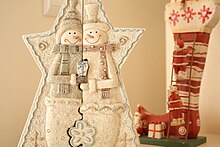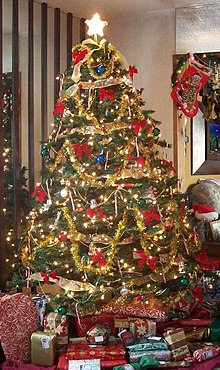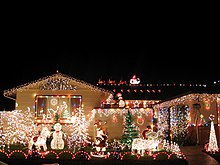Christmas decoration




A Christmas decoration is any of several types of ornamentation used at
In many countries, such as
History
Christmas decorations are mentioned in ancient descriptions of the Roman feast Saturnalia, which was believed to have originated in the 5th century BC.
The tradition of decorating a tree is old since the
Tertullian complained to the 2nd century that Christians in North Africa decorated their homes with greenery, a pagan symbol.[8]
Tree

The
Types of decorations
Glass ornaments
Figural glass
Sometimes, competitions were held. Prizes were awarded to the family, producing the finest examples. Santa Clauses, angels, birds, animals, and other traditional
F.W. Woolworth discovered these glass ornaments on a toy and doll-buying trip to
For the American market, figures depicting comic book characters and patriotic subjects such as Uncle Sams, eagles, and flags were blown. Glassblowers have held on to the old molds. Glass ornaments are still created from these old molds.
Method
A clear glass tube is heated over an open flame. It is then inserted into a mold. The glassblower then blows into the end of the tube. The glass expands to fill the mold. The glass takes on the shape of the mold. It is cooled. A silver nitrate solution is swirled about inside the ornament. This gives the ornament a silver glow. The outside of the ornament is painted or decorated with metal trims, paper clippings, etc.[21]
Cotton batting
Cotton batting Christmas ornaments were popular during the German Christmas toy and decoration boom at the turn of the century. They were exported in large numbers to the United States. These decorations suggested puffs of snow. Fruits and vegetables were popular subjects and often had a realistic appearance. African-American and patriotic characters were fashioned for the American market. Some ornaments were used to hide boxes of candy.
Assembling these decorations was a cottage industry. Cotton batting was wound around a wire frame resembling a human or animal. A face was painted, or a lithograph cut-out was affixed to the batting. Figures were given crepe paper costumes. Some were touched with glue and sprinkled with mica flakes for a glittering appearance.[23]
Dresden
Dresdens are three-dimensional ornaments. They are made of paper, card, or cardboard. Dresdens were produced mostly in
Positive and negative molds were set into a press. A moistened sheet of card was put into the press. The images were pressed. When they had dried, they were sent to cottage workers for the finishing touches. This involved separating the form-halves from the card, trimming ragged edges, and gluing the two halves together. The form was then gilded, silvered, or hand-painted. Sometimes, a small gift or sweet was put into the form. Forms were usually no larger than five inches.[24][25]
Plants
Since the nineteenth century, the poinsettia, a native plant from Mexico, has been associated with Christmas
Different places also have different traditions and
Outdoors


In
Others
In the
In many countries, a representation of the
Among the most popular items of Christmas decorations are stockings. According to legend, Saint Nicolas would creep in through the chimney and slip gold into stockings hanging by the fireplace. Various forms of stockings are available, from simple velvet ones to sock-shaped bags to animated ones.
Season

Christmas decorations are typically put up in late November or early December, usually to coincide with the start of

In some places, Christmas decorations are traditionally taken down on
In England, it was customary to burn the decorations in the hearth. However, this tradition has fallen out of favour as reusable and imperishable decorations made of
In the United States, many stores immediately remove decorations the day after Christmas, as some think of the holiday season as being over once Christmas has passed.[citation needed] A vast majority of Americans who put up home decorations keep them out and lit until at least New Year's Day, and inside decorations can often be seen in windows for several weeks afterward.
-
Christmas ornaments hanging on a Christmas Tree
-
Christmas decorations at the Indooroopilly Shopping Centre, Australia, 2020
-
Christmas wreath
References
- ^ "The Putz and Illumination". Moravian Church. November 19, 2018. Retrieved December 3, 2023.
- ISBN 9782067182110.
Advent – The four weeks before Christmas are celebrated by counting down the days with an advent calendar, hanging up Christmas decorations and lightning an additional candle every Sunday on the four-candle advent wreath.
- ISBN 978-0-664-50147-1.
Another popular activity is the "Hanging of the Greens," a service in which the sanctuary is decorated for Christmas.
- ^ "Candlemas". British Broadcasting Corporation. Retrieved April 9, 2014.
Any Christmas decorations not taken down by Twelfth Night (January 5th) should be left up until Candlemas Day and then taken down.
- ISBN 978-0-7387-3450-7. Retrieved April 9, 2014.
- ^ McGregor, Kate (November 30, 2023). "It's Bad Luck To Take Your Tree Down Before January 6". AOL.
According to the tradition of the 12 days of Christmas (explained above), January 6 is the earliest you should be taking down your Christmas tree. According to the legend, bad luck will befall those who stop the Christmas cheer any earlier.
- ^ / FR / cadre_repertoire / social / Reflexion / Noel / noel_origines.html The millennial cult of the sun
- ^ Cafe-discoveries / Sons / Le-Pere-Noel-est-il-une-junk-350601 / Is Santa Claus a junk? Archived June 1, 2013, at the Wayback Machine Broadcast from Europe 1, December 24, 2010
- ISBN 9781451424331.
The Christmas tree as we know it seemed to emerge in Lutheran lands in Germany in the sixteenth century. Although no specific city or town has been identified as the first to have a Christmas tree, records for the Cathedral of Strassburg indicate that a Christmas tree was set up in that church in 1539 during Martin Bucer's superintendency.
- ^ "The Christmas Tree". Lutheran Spokesman. 29–32. 1936.
The Christmas tree became a widespread custom among German Lutherans by the eighteenth century.
- ISBN 9780814639320.
German Lutherans brought the decorated Christmas tree with them; the Moravians put lighted candles on those trees.
- ISBN 9781442225909.
Many Lutherans continued to set up a small fir tree as their Christmas tree, and it must have been a seasonal sight in Bach's Leipzig at a time when it was virtually unknown in England, and little known in those farmlands of North America where Lutheran immigrants congregated.
- ISBN 9781554390984.
The eight-pointed star became a popular manufactured Christmas ornament around the 1840s and many people place a star on the top of their Christmas tree to represent the Star of Bethlehem.
- ^ Wells, Dorothy (1897). "Christmas in Other Lands". The School Journal. 55. E.L. Kellogg & Company: 697–8.
Christmas is the occasional of family reunions. Grandmother always has the place of honor. As the time approaches for enjoying the tree, she gathers her grandchildren about her, to tell them the story of the Christ child, with the meaning of the Christ child, with the meaning of the Christmas tree; how the evergreen is meant to represent the life everlasting, the candle lights to recall the light of the world, and the star at the top of the tree is to remind them of the star of Bethlehem.
- ISBN 9780191614910.
The same ambiguity is seen in that most familiar of angels, the angel on top of the Christmas tree. This decoration, popularized in the nineteenth century, recalls the place of the angels in the Christmas story (Luke 2.9–18).
- ISBN 1-56718-765-X
- John Wiley & Sons.
His biographer, Eddius Stephanus, relates that while Boniface was serving as a missionary near Geismar, Germany, he had enough of the locals' reverence for the old gods. Taking an axe to an oak tree dedicated to Norse god Thor, Boniface chopped the tree down and dared Thor to zap him for it. When nothing happened, Boniface pointed out a young fir tree amid the roots of the oak and explained how this tree was a more fitting object of reverence as it pointed towards the Christian heaven and its triangular shape was reminiscent of the Christian trinity.
- ^ Harper, Douglas, Christ, Online Etymology Dictionary, 2001.
- ^ "The Chronological History of the Christmas Tree". The Christmas Archives. Archived from the original on December 21, 2007. Retrieved December 18, 2007.
- ^ Shoemaker, Alfred Lewis. (1959) Christmas in Pennsylvania: a folk-cultural study. Edition 40. p.52,53.
Stackpole Books 1999. ISBN 0-8117-0328-2
- ^ a b Merck (1992), p. 43
- ^ Merck (1992), p. 41
- ^ Merck (1992), pp. 65-69
- ^ Merck (1992), pp. 54–63
- ^ Smith and Smith (1993), p. 56
- ^ a b "Good luck or bad? How Christmas decorating traditions vary in England". the Guardian. December 2, 2022. Retrieved January 5, 2023.
- ^ Murray, Brian. "Christmas lights and community building in America," Archived October 26, 2006, at the Wayback Machine History Matters, Spring 2006.
- ^ BBC – London's Oxford Street and Regent Street Christmas lights have been switched on at precisely the same time.
- ^ Twelfth Night Traditions Archived September 5, 2015, at the Wayback Machine




